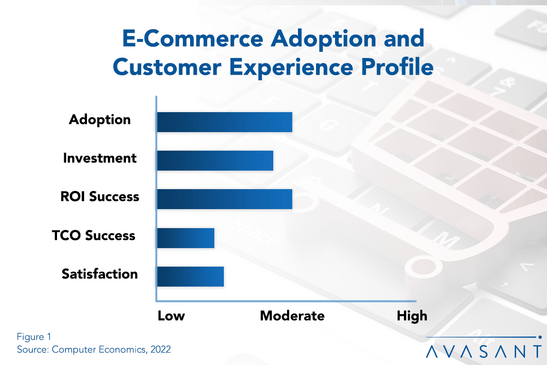E-commerce technology, while mature, is still evolving. The continued growth in online sales requires e-commerce systems to be flexible, scalable, and easy to use. Businesses are shifting from a product-centric to a customer-centric approach. Customer experience is now the focal point as e-commerce systems enable hyperpersonalization. Businesses are also incorporating omnichannel strategies to further enhance customer experience by ensuring that processes are seamless across platforms and devices.
Nevertheless, as shown in Figure 1 from the full report, E-Commerce Adoption Trends and Customer Experience , the customer experience for e-commerce systems is mixed. Compared with other technologies, we classify e-commerce systems as offering a moderate return on investment (ROI) success rate, a low total cost of ownership (TCO) success rate, and a moderate satisfaction rate.

E-commerce systems are exactly as the name implies: systems that enable organizations to transact business electronically, primarily through the internet. Although the internet can and should be used in countless ways to develop and enrich the customer experience, it is business transactions that are the defining characteristic of e-commerce.
However, as its use has boomed, e-commerce has become increasingly complex. Moving beyond stand-alone web storefronts, e-commerce systems now interface with customer relationship management (CRM) systems, supply chain management systems, and enterprise resource planning (ERP) systems to provide real-time data for managing inventory and forecasting customer demand. E-commerce systems also include the use of web application program interfaces (APIs) that allow buyer and seller systems to communicate directly. At the same time, older electronic data interchange (EDI) systems continue to be deployed and extended in B2B commerce. All of these—website commerce, web APIs, and EDI systems—fall under our definition of e-commerce systems.
“The pandemic brought about a huge increase in e-commerce transactions, as consumers flooded sellers with online orders,” said Tracell Frederick, research analyst for Avasant Research, based in Los Angeles. “Most organizations now have no choice other than to view e-commerce as strategic investment to ensure implementation success.”
Starting in the retail industry, e-commerce today is deployed by companies in virtually all sectors to do business with customers. Banks use it for online banking. Healthcare providers use it not only for billing, but for appointments, scheduling, and patient workflow. Governments use it to allow citizens to pay taxes. Charities and nonprofits use it to collect donations. There is scarcely a business transaction that cannot be performed today using e-commerce. As such, we expect e-commerce systems to continue to grow inside its traditional role with retailers and beyond as APIs and cloud platforms make it easier to implement and capabilities increase.
The full report provides an overview of e-commerce adoption and investment trends, providing data on how many organizations have the technology in place, how many are in the process of implementing it, and how many are expanding implementations. We also look at the ROI experience, TCO experience, and considered or planned uses for new e-commerce investment. We conclude with important principles to apply in planning and implementing e-commerce systems.
This Research Byte is a brief overview of our report on this subject, E-Commerce Adoption Trends and Customer Experience. The full report is available at no charge to our subscribers, or it may be purchased by non-clients directly from our website (click for pricing).





